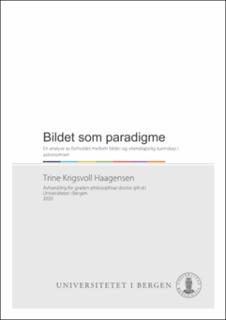Bildet som paradigme : En analyse av forholdet mellom bilder og vitenskapelig kunnskap i astronomien.
Doctoral thesis

Åpne
Permanent lenke
https://hdl.handle.net/1956/24061Utgivelsesdato
2020-09-17Metadata
Vis full innførselSamlinger
Sammendrag
Picture as paradigm: an analysis of the relationship between images and scientific knowledge in astronomy. This thesis analyses and discusses the relationship between images and scientific knowledge in astronomy through three cases, namely through the introduction of the telescope, photography and contemporary imaging technologies exemplified by European Space Agency’s Planck all sky image. The project discusses astronomical images from the 17th century until today and can thus be considered a cross-historical and trans-disciplinary contribution to the fields of art history, media studies and visual studies. The ambition of the thesis is twofold. First, I want to expand the empirical knowledge of the academic fields mentioned. Second, I hope that the cross-historical and trans-disciplinary analysis will contribute with a surplus – teach us something new about images that we otherwise wouldn’t see. The project is governed by the overall premise that imaging makes a difference in what and how we see and know. It also starts with the hypothesis that the identities and status of images are destabilized and challenged when new visualization technologies are introduced in astronomy. By regarding the pictures in question as working and epistemic, they are seen as active, productive, partaking and formative in the constitution of their subjects, of those who produce them and use them, and the fields they partake in. The notion of the apparatus is used in the thesis, as it allows a distinction to be made between two types of apparatus: the concrete apparatus, i.e. imaging technologies and the images, and the expanded - discursive, theoretical, bodily, perceptible – apparatus. Images become intelligible as and when the concrete and expanded apparatuses match each other and fall into place. Paradigm is a central and productive term in the thesis. The concept of paradigm is seen and treated as complex and ambiguous. Rather than fixating the term into a stable, concise and final meaning, I explore the wide range of the term, and let it work productively in the abundance of astronomical images and visualization, as well as in the uses and understandings of these pictures. Picture as paradigm can thus not be seen as a suggestion to a conclusion regarding what pictures are in general, but as a proposal to understand how astronomical images mean and make sense, and to how we better can approach images on their own terms.